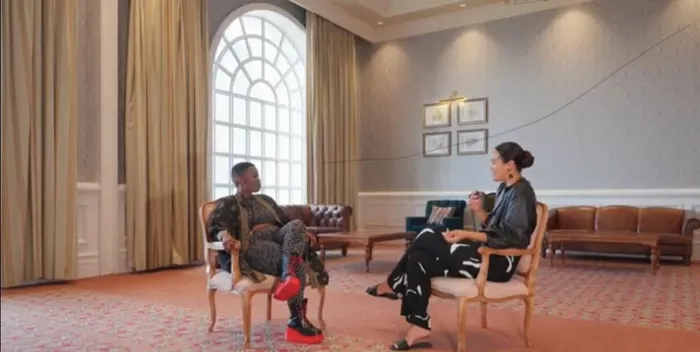Jo-Ann Strauss and Zolani Mahola unite to highlight the importance of art in South Africa

Join Jo-Ann Strauss and Zolani Mahola in a heartfelt discussion about the transformative power of art in South Africa
Image: YouTube/screenshot
Jo-Ann Strauss and Zolani Mahola come together with a shared purpose.
Sometimes, when two voices meet in South African culture, the result is more than just a conversation.
That is what happens in the latest episode of Jo-Ann Strauss's "ARTdacity" podcast, where the well-known media figure talks with Zolani Mahola, the beloved singer from Freshlyground.
This warm exchange quickly becomes a powerful reminder of why African art matters and why South Africa urgently needs more young people to step into their creative gifts.
At its core, the episode reveals why art serves as a lifeline for South Africa's youth, offering them a crucial means of expression and identity.
“Art is not something to be glanced at; it's meant to be engaged with, wrestled with, and absorbed,” is the podcast tagline. Strauss is hoping to use it as a stepping stone to make art come alive, challenging a passive approach to creativity.
Her words resonate with listeners, sparking discussions that reframe a common belief about the role of art in our lives, encouraging a more profound engagement.
In a world where everything scrolls past us in seconds, Strauss is asking South Africans to slow down, listen deeply, and reconnect with the stories that shape us. The podcast is a call to bring presence back to creativity, a reminder that art is not just aesthetic; it is identity, memory and healing.
For too long, contemporary African artists have been underrepresented or misunderstood. Strauss wants their work to be felt, not just seen.
If one voice has captured South Africa’s spirit, its joy, pain, rhythm, and hope, it is Mahola’s.
From "Doo Be Doo" to "Waka Waka", her voice didn’t just soundtrack a generation; it became part of our cultural DNA. But in this conversation, she reveals the quiet, powerful roots of where her artistry began.
Growing up in New Brighton, art wasn’t something in galleries; it lived in the streets.
Mahola explains how art came alive for her people “toy-toying and creating these flash-mob-like moments,” crowds breaking into harmony as naturally as breathing.
"I think we are lucky in one way in South Africa that art is always around us, it's kinda in our blood, for me the art that I would've seen would've been people, literally toy toying and creating these almost like flash mobs, just people osmotically coming together singing in one voice in harmony.”
“It’s in our blood,” she says in conversation. “It’s in the water. We didn’t necessarily call it...(Yi art lena) art, but it was.”
Church choirs, protests and street songs that was her first training. That was her South African Art School.
Art is healing not only for the audience, but for the artist
What many fans don’t know is that after Freshlyground, Mahola went through her own internal transformation. She had been singing for nearly two decades but realised she had lost connection with her own voice.
Her last five years have been about returning to that voice, not the famous one, but the intimate one.
“I want my art to be medicine,” she tells Strauss. “First for me, and then for anyone who needs it.”
Parenthood sharpened that purpose.
She wants her children and the children of South Africa to see that they, too, have a voice, whether it sings, dances, designs, paints or heals.
Art as a tool for identity, healing, and future-building
Strauss and Mahola agree: South Africa’s children are growing up in a world that demands resilience.
Many are exposed to things no child should face. That is why, Mahola says, access to the creative arts is not a luxury; it’s essential.
“It’s how children process the world,” she says. “It’s how they discover who they are.”
Art was once part of South Africa’s protest. Today, it must be part of our healing.
“We are the grown-ups now, and the responsibility is ours.”
At one point, Mahola makes an observation that hangs heavy in the air: “We can’t say Mandela didn’t do enough. They did what they could. Now we are the grown-ups. We are the mothers and fathers of this nation.”
And part of that responsibility, they agree, is creating platforms where young creators feel seen, safe, and encouraged.
Because the next global voice might be sitting in a township choir.
The next world-travelled storyteller might be drawing in a classroom right now. All they need is a sense that their dreams are valid.
Their conversation is warm and deeply South African. Mahola peppers her sentences with familiar isiXhosa affirmations, “ewe sisi man”, that pull you right into the room. At one point, Strauss tries a little isiXhosa herself, creating a gentle moment that reminds you of our shared culture.